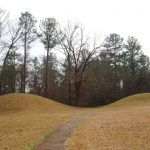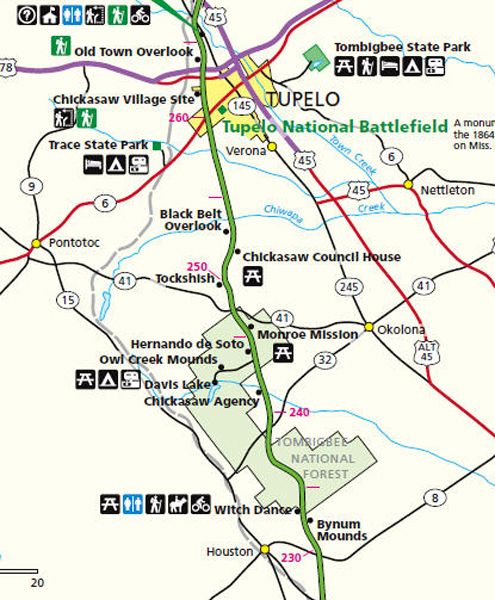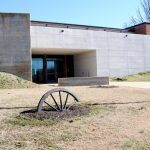Natchez Trace Parkway from milepost 222 to 268
| Milepost | Points of Interest: |
| 232.4 | 
Bynum Mound and Village – A Middle Woodland period Native American mound site. This archeological site consisted of six mounds, five excavated in the 1940s. Two of the largest mounds have been restored, and you can see them today. The Village Site displays exhibits that portray daily life and early history at the Chickasaw Village that once stood here. |
| 233.2 | Witch Dance – The very name conjures visions of swirling black capes, eerie moonlight in a shadowed forest, and a cauldron of bubbling potion over a roaring fire. Was it so? Local legend says, “yes!” Though the site serves as a campground today, tales of danger have persisted for centuries, allegedly making it one of the most haunted places in the Magnolia State. |
| 243.1 | Side Trip – Owl Creek Mounds – Protected by the U.S. Forest Service, Owl Creek Mounds is an important Native American ceremonial site. The mounds were built and used by farming people from the Mississippian culture, A.D. 1000 TO 1500. The archaeological site includes two large mounds, walkways, and interpretive panels. The mounds are located three miles west of the Natchez Trace. Exit the Trace at milepost 243.1. Another mile down the road will take you to Davis Lake Recreation Area. |
| 243.3 | Hernando de Soto – In this vicinity, the Spanish explorer Hernando de Soto crossed the animal path that later became the Natchez Trace. In 1539, he embarked on a long, arduous journey that took him across the southeastern United States. He crossed the Tombigbee River east of here in December 1540 and spent the ensuing winter among the nearby Chickasaw Indians. Later attacked by the Indians, de Soto and his army moved westward. He is credited with discovering the Mississippi River somewhere south of Memphis, Tennessee, in June 1541. |
| 245.6 | Monroe Mission – Located northwest of here, the Chickasaw Indians first received Christianity and education in 1822. Five years later, 100 acres were under cultivation, and 81 pupils were attending the school. Boys learned farming and carpentry, and girls learned spinning and weaving in addition to classroom work. More than 150 persons were baptized in the church, a small room not over 16 by 16 feet. In front was a large arbor covered with brush and seeded with puncheons for summer meetings. Monroe and three other stations were the training centers for many who became leaders of the Chickasaw in Oklahoma. |
| 249.6 | Tockshish – Named for a Chickasaw word meaning “tree root,” Tockshish was a community of Indians and white men on the Natchez Trace to the northwest. John McIntosh, a British agent to the Choctaw, first settled there before 1770. In 1801, McIntosh’s was made the second post office between Nashville, Tennessee, and Natchez, Mississippi, and a relay station where post riders exchanged weary horses for fresh ones. The post office is gone – only the name recalls when hoof beats marked the arrival of mail bags that had left Nashville five days before and were due in Natchez seven days later. |
| 251.1 | Chickasaw Council House – Westerly on the Natchez Trace stood an Indian village, Pontatock, with its council house, which in the 1820s became the capital of the Chickasaw Nation. The chiefs and the headmen met there to sign treaties or establish tribal laws and policies. Each summer, 2,000 or 3,000 Indians camped nearby to receive an annual payment for lands they had sold to our Federal government. After the treaty of 1832, the last land was surrendered. The council house disappeared, but its memory remains in the names of a Mississippi county and town that went west with the Chickasaw as a county and village in Oklahoma. |
| 251.9 | Black Belt Overlook – Ages ago, this area was under an arm of the ocean. Shells and other marine organisms were deposited to form the limestone seen here. Exposure of the limestone to all types of weathering gradually changed it into a heavy fertile soil of various colors. The dominant black soil, which before cultivation was prairie grassland, has given the area the name black belt, or black prairie. The black belt extends south beyond Columbus, Mississippi, then trends eastward across nearly all of Alabama. Formerly one of America’s great cotton areas, it is now considered an excellent pasture for livestock. |
| 259.7 | Side Trip – Battle of Tupelo – In the early morning of July 14, 1864, this battle ended north of Tupelo in the late afternoon of July 15. The Battle of Tupelo was a Union victory over Confederate forces, which ensured the safety of General William T. Sherman’s supply lines. Exit the Trace at milepost 259.7 onto Mississippi Highway 6 (Main Street in Tupelo) and travel east 1 mile.
In addition to the National Battlefield, two more interesting sites can be seen in Tupelo: Elvis Presley Birthplace – Elvis Presley was born in Tupelo, Mississippi. Tour the home where the King of Rock & Roll began his musical journey to fame. The two-room house where Elvis was born on January 8, 1935, is seen by over 50,000 visitors yearly. Exit the Trace at milepost 259.7 onto Mississippi Highway 6 (Main Street in Tupelo) and travel east a couple of miles through town. After you cross U.S. 45, turn left onto Elvis Presley Drive. Tupelo Automobile Museum – This museum features 120,000 square feet of automobile displays and open-viewing restoration bays. Over 100 antique, classic and collectible automobiles, chronologically displayed, illustrate over 100 years of automobile design and engineering progress. The collection, valued at over $6 million, includes a rare Tucker, a Lincoln previously owned by Elvis Presley, other movie and celebrity vehicles, Hispano Suizas, a Duesenberg, and many more rare brands and American favorites. Exit the Trace at milepost 259.7 onto Mississippi Highway 6 (Main Street in Tupelo) and travel east about a mile. Turn left on Franklin Street, and the museum will be on your right. |
| 261.8 | Chickasaw Village Site – An archaeological site that represents the village that once occupied the area. While no structures are standing today, there is an outline of a Chickasaw winter home, summer home, and fort. A short nature trail gives more information on the native uses of plants in the area. This site also allows access to the Natchez Trace National Scenic Trail for those interested in longer walks. You can hike north to Old Town Overlook and the Tupelo Visitors Center. |
| 263.9 | Old Town Overlook – In the early 1800s, ordinary Americans could not be bothered with learning Chickasaw villages’ names on the Natchez Trace. One they called Old Town and passed the name on to the stream running through this valley. This is one of the Tombigbee River sources, first called the “River of the Chickasaw” and later the “Tombeckbee” by the French. Near here in 1795, the Chickasaw defeated the Creek in a battle described by Andrew Jackson as “When the whole Creek nation came to destroy your towns…a few hundred Chickasaw aided by a few whites chased them back to their nation, killing the best of their warriors and covering the rest with shame. You can hike north to the Tupelo Visitors Center or south to the Chickasaw Village Site. |
| 266 | Natchez Trace Parkway Visitor Center, Tupelo, Mississippi – Provides an orientation film, interpretive displays, and an Eastern National Bookstore. A park ranger is available 8 am–5 pm daily (except Christmas Day). |
| About 268.0 (northbound) | Side Trip – Corinth, Mississippi – Corinth, the county seat of Alcorn County, is about 35 miles west of the Natchez Trace Parkway. Corinth has many cultural heritage sites — four museums, the National Park Service Civil War Interpretive Center, pristine Civil War earthworks, historic neighborhoods, churches and cemeteries, and much more. Visitors to Corinth can take a self-guided Civil War driving tour. Stops on the route include the Corinth National Cemetery, the Contraband Camp, the site of Battery Powell, Generals’ Headquarters, and Battery F.
Corinth Civil War Interpretive Center – For six months in 1862, Corinth, a critical railroad junction, captured a divided nation’s full attention. Today, one of the National Park Service’s newest visitor centers interprets Corinth, Mississippi’s key role in the Civil War’s Western Theater. The 15,000-square-foot modern facility features interactive exhibits, a multimedia presentation on the Battle of Shiloh, and a video on Corinth’s Battle. The interpretive center stands near the site of Battery Robinett, a Union fortification witness to bloody fighting during the October 1862 Battle of Corinth. Open every day except Christmas Day from 8:30 a.m. to 4:30 p.m. It is located at 501 W. Linden Street. Corinth Contraband Camp – 902 North Parkway, 662.287.9273, No admission, Open dawn to dusk. Many African Americans who fled Southern plantations and farms seeking freedom and protection found the Union-occupied Corinth a secure location. Union General Grenville Dodge understood what effect the defection of thousands of African Americans would have on the Confederate War effort. He began to enlist the escaped slaves who came into his lines as teamsters, cooks, and laborers. He actively recruited male refugees, armed them, and placed them in charge of security at the newly organized contraband camp in Corinth. Dodge’s refugee administrative efforts led to the formation of the 1st Alabama Infantry Regiment of African Descent. Consisting of approximately 1,000 men. Coca-Cola Museum – In 1905, Avon Kenneth Weaver bought an interest in the Corinth Bottle Works, a small soda water plant. At that time, Coca-Cola was produced in Jackson, Tennessee, and shipped by rail to Corinth. Mr. Weaver obtained a Coca-Cola franchise for Northeast Mississippi in 1907. The same family still owns the company. The Coca-Cola Museum is located in downtown Corinth. The museum exhibits include historical images, artifacts from the past 100 years, and interactive computer stations with information about the 100 years of Corinth Coca-Cola. 305 Waldron Street. Historic Downtown Corinth – Several historic buildings and businesses can be seen here, including Borroums Drug Store, 1865, by former CSA army surgeon A.J. Borroum. It is the oldest drug store in continuous operation in Mississippi. Biggers Hardware opened its doors in 1918 and has been a community’s mainstay. Waits Jewelry and Fine Gifts is the oldest business in Corinth, dating from 1865. If you are traveling north on the Trace, exit onto Mississippi Highway 145 near Tupelo, then go north on U.S. 45 to Corinth. If you are traveling south on the Trace, exit onto U.S. 72 at milepost 320 and travel west to Corinth. |
Continue to mileposts 269 to 308


